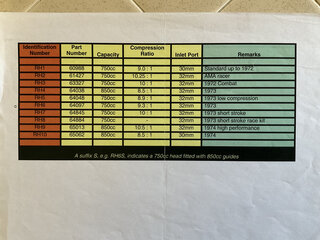- Joined
- Jan 18, 2021
- Messages
- 5
Greetings all - looking to increase my knowledge regarding my 1973 750 "Low Compression" Combat... Date stamp reads "1972 NOV", VIN 212451...
Has "C" head, 32mm carbs, Combat breather assembly, silver barrel, black gauge holders, steel side covers, stainless fenders, '73 "basket weave" seat, rectangular L917 taillight... Identical in pretty much every way (other than the breather and stamping on head) to my '73 850...
I was always told by "knowledgeable" Norton folks that this bike is a "low compression" Combat, but never got a satisfactory explanation of what this means exactly... How much "lower"? Lower than what?? what was changed relative to earlier Combats (other than the Superblends)?
And - how many of this version of the Combat were produced?
Educate me please!
Thanks in advance from San Jose California!
HJ
Has "C" head, 32mm carbs, Combat breather assembly, silver barrel, black gauge holders, steel side covers, stainless fenders, '73 "basket weave" seat, rectangular L917 taillight... Identical in pretty much every way (other than the breather and stamping on head) to my '73 850...
I was always told by "knowledgeable" Norton folks that this bike is a "low compression" Combat, but never got a satisfactory explanation of what this means exactly... How much "lower"? Lower than what?? what was changed relative to earlier Combats (other than the Superblends)?
And - how many of this version of the Combat were produced?
Educate me please!
Thanks in advance from San Jose California!
HJ


